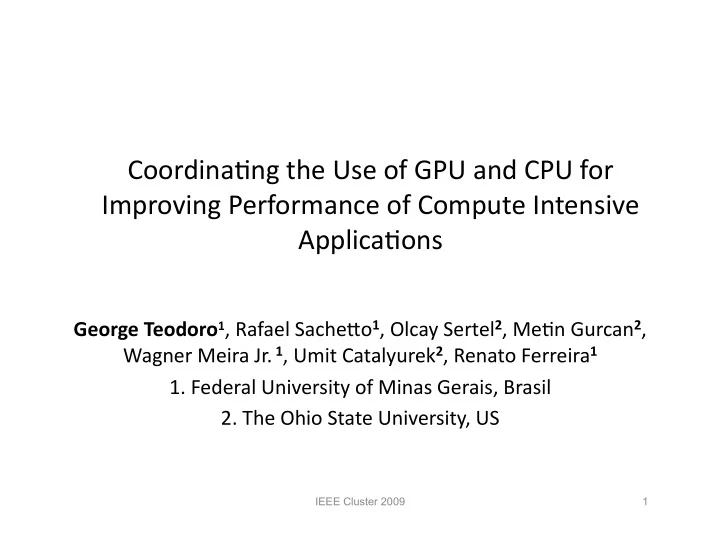

Coordina(ng the Use of GPU and CPU for Improving Performance of Compute Intensive Applica(ons George Teodoro 1 , Rafael Sache>o 1 , Olcay Sertel 2 , Me(n Gurcan 2 , Wagner Meira Jr. 1 , Umit Catalyurek 2 , Renato Ferreira 1 1. Federal University of Minas Gerais, Brasil 2. The Ohio State University, US IEEE Cluster 2009 1
Mo(va(on • High performance compu(ng – Large cluster of‐the‐shelf components – Mul(‐core/Many‐core – GPGPU • Massively parallel • High speedups compared to the CPU IEEE Cluster 2009 2
Mo(va(on • But... GPU is not so fast in all scenarios... • Current frameworks – Assume exclusive use of GPU or CPU IEEE Cluster 2009 3
Goal • Target heterogeneous environments – Mul(ple CPU‐cores/GPUs – Distributed environments • Efficient coordina(on of the devices – Scheduling tasks according to their specifici(es • High level programming abstrac(on IEEE Cluster 2009 4
Outline • Anthill • Suppor(ng heterogeneous environments • Experimental evalua(on • Conclusions IEEE Cluster 2009 5
Anthill • Based on the filter‐stream model (DataCu>er) – Applica(on decomposed into a set of filters – Communica(on using streams – Transparent instance copy – Data flow – Mul(ple dimensions of parallelism • Task parallelism • Data parallelism IEEE Cluster 2009 6
Anthill A B C IEEE Cluster 2009 7
Filter programming abstrac(on • Event driven interface – Aligned with the data flow model • User provide data processing func(ons to be invoked upon availability of data • System controls invoca(on of user func(on – Dependency analysis – Parallelism IEEE Cluster 2009 8
Event handlers • User provided func(ons • Operate on data objects – Updates filter state (global) – May trigger communica(on – Returns aZer processing the data element • Gets invoked automa(cally when data is available – And dependencies are met
Suppor(ng heterogeneous resources • Event handler implemented to mul(ple devices – Each filter may be implemented targe(ng the appropriate device • Mul(ple devices used in parallel • Anthill run‐(me chooses the device for each event IEEE Cluster 2009 10
Heterogeneous support overview IEEE Cluster 2009 11
Device scheduler • Assumes – Events are independent – Out‐of‐order execu(on • Scheduling policies – FCFS – first ‐come, first‐served – DWDR – dynamic weighted round robin • Orders events according to its performance to each device • Selects the event with the highest speedup • User given func(on IEEE Cluster 2009 12
Neuroblastoma Image Analysis System • Classify (ssues in different subtypes of prognos(c significance • Very high resolu(on slides – Divided in smaller (les • Mul(‐resolu(on image analysis – Mimics the way pathologists examine them IEEE Cluster 2009 13
Anthill implementa(on IEEE Cluster 2009 14
Experimental results • Setup – 10 PCs with an Intel Core 2 Duo CPU 2.13GHz / NVIDIA GeForce 8800GT GPU – 4 PCs with a dual quad‐core AMD Opteron 2.00GHz processor/ NVIDIA GeForce GTX 260 – Input data: images of 26,742 (les using two resolu(on levels: 32x32 and 512x512 IEEE Cluster 2009 15
NBIA tasks analysis – performance varia(on Dual quad-core AMD Opteron 2.00GHz/NVIDIA GeForce GTX260 IEEE Cluster 2009 16
Heterogeneous scheduling analysis 16 + 1 = 30 ?? Recalc (%) 12 Resolu(on Low High 1 CPU core‐ FCFS 263 215 1 CPU core – DWRR 21592 4 IEEE Cluster 2009 17
Heterogeneous scheduling analysis FCFS DWDR IEEE Cluster 2009 18
Heterogeneous scheduling analysis # of CPU cores FCFS DWRR Low High Low High 1 637 58 10714 1 2 117 133 15748 2 3 1925 173 18614 5 4 2090 219 18634 28 5 2872 286 20070 40 6 3819 393 20147 76 7 4726 478 20266 57 IEEE Cluster 2009 19
Distributed environment evalua(on IEEE Cluster 2009 20
Conclusions • Rela(ve performance between CPU/GPU is data dependent • Adequate scheduling among heterogeneous processors doubled the performance of the applica(on • Neglect the CPU is a mistake • Data‐flow is an interes(ng model to exploit parallelism IEEE Cluster 2009 21
Future work • New scheduling techniques • Execu(on in cluster with heterogeneity among the compu(ng nodes IEEE Cluster 2009 22
Ques(ons? IEEE Cluster 2009 23
Recommend
More recommend